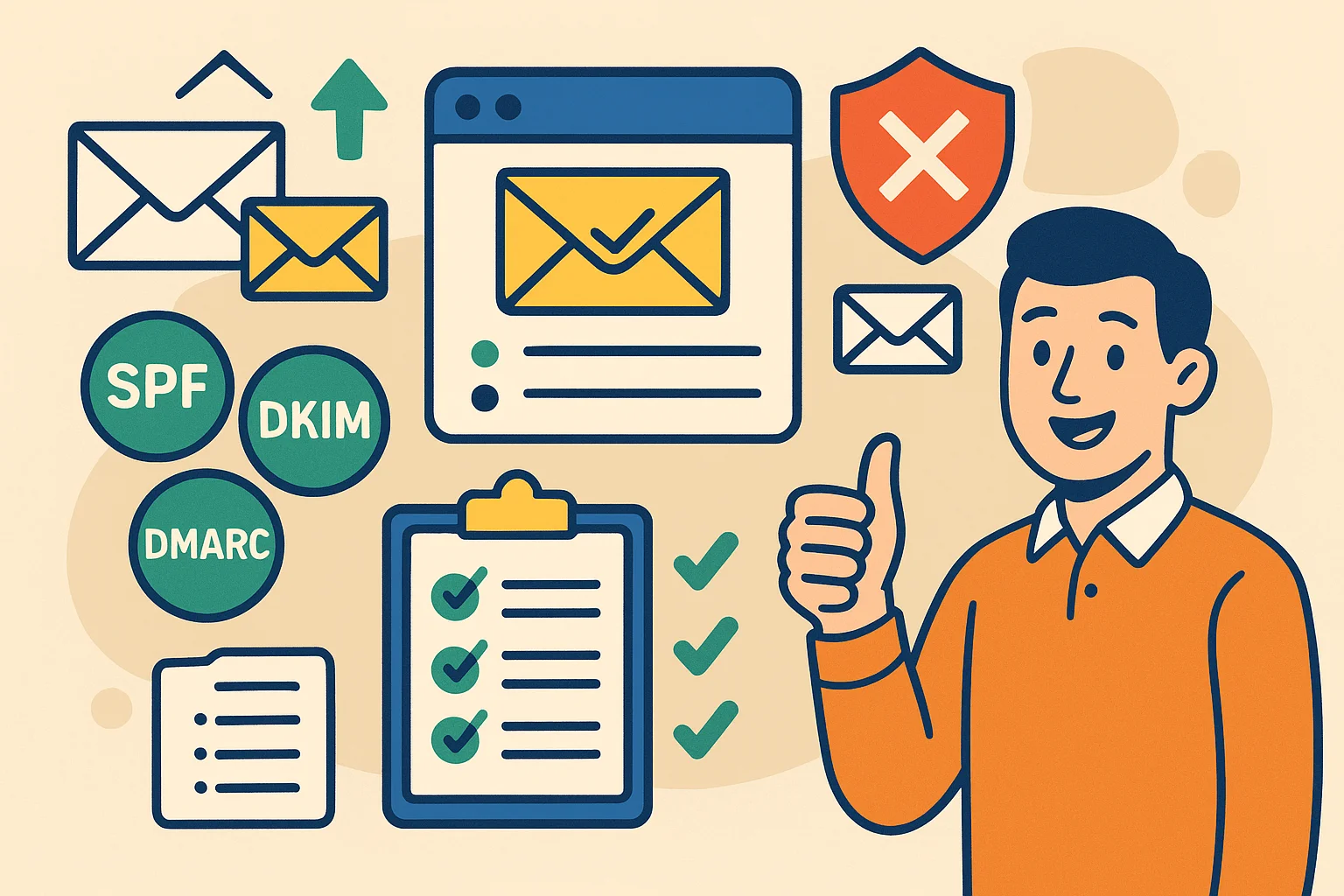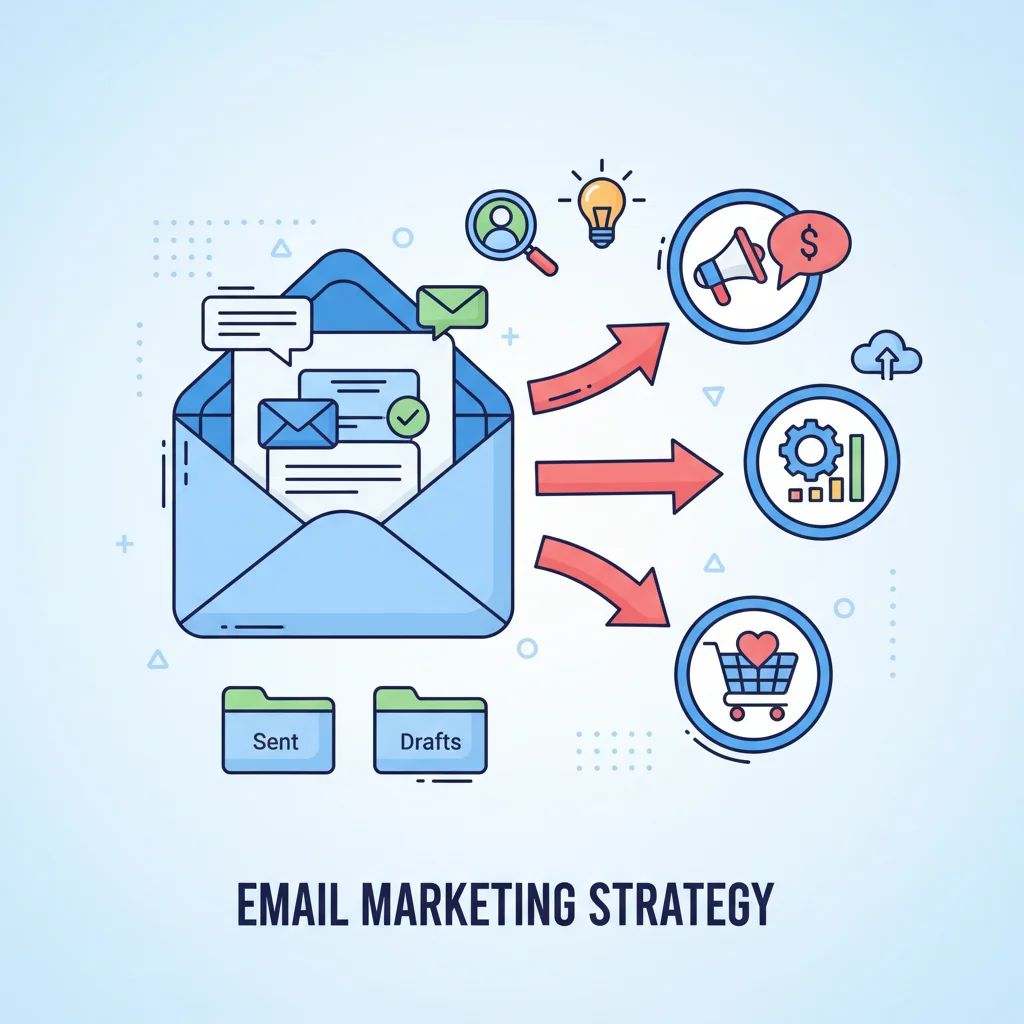Now Reading: Stop Landing in Spam: 10 Email Deliverability Improvement Tips
-
01
Stop Landing in Spam: 10 Email Deliverability Improvement Tips
Stop Landing in Spam: 10 Email Deliverability Improvement Tips

Ever sent an important email campaign only to discover it vanished into the spam abyss? Nothing’s more frustrating than crafting the perfect message that nobody sees. Your open rates plummet, conversions tank, and your marketing efforts go to waste. But don’t worry – I’ve got the email deliverability improvement tips you need to break through the noise and land right where you belong: the inbox.
Key Takeaways
How to improve your email deliverability:
- Authenticate your emails with SPF, DKIM, and DMARC protocols to verify your identity to email providers
- Maintain a clean email list by regularly removing inactive subscribers and invalid addresses
- Warm up new domains and IPs gradually before sending high volumes
- Craft engaging, personalized content with clear subject lines that avoid spam triggers
- Monitor your sender reputation and engagement metrics to catch issues early
- Follow consistent sending practices with proper timing and frequency
- Use double opt-in and honor unsubscribe requests promptly
- Test your emails before sending to identify potential deliverability issues
Email Authentication: Your Digital ID Card
Think of email authentication as your digital ID card. Without it, you’re just some suspicious character trying to get into the inbox party. I can’t stress this enough-proper authentication is the foundation of good email deliverability.
Set Up SPF, DKIM, and DMARC
These three authentication protocols work together like bouncers checking IDs at the club:
- SPF (Sender Policy Framework): Tells receiving servers which mail servers are authorized to send emails from your domain
- DKIM (DomainKeys Identified Mail): Adds a digital signature to verify your emails haven’t been tampered with
- DMARC (Domain-based Message Authentication): Provides instructions on how to handle unauthenticated messages
Setting these up requires adding specific TXT records to your domain’s DNS settings. It might sound technical, but most email service providers offer step-by-step guides. Trust me, this step alone can dramatically improve your deliverability.
Use a Subdomain for Email Campaigns
I’ve found that registering a separate subdomain (like email.yourcompany.com) exclusively for email marketing helps isolate your sending reputation. This way, if deliverability issues occur, they won’t affect your main domain’s reputation.
Useful Articles:
List Hygiene: Clean House, Better Results
Your email list is like your house-let it get messy, and problems start piling up. A clean list is crucial for maintaining good deliverability.
Remove Inactive Subscribers
I regularly purge subscribers who haven’t engaged with my emails in 3-6 months. Yes, it hurts to see those numbers go down, but inactive subscribers:
- Damage your engagement metrics
- Increase the risk of spam traps
- Waste your sending resources
Before removing them completely, try a re-engagement campaign. Something like “We miss you!” or “Do you still want to hear from us?” can sometimes wake up dormant subscribers.
Implement Double Opt-in
Double opt-in means subscribers confirm their email address by clicking a link in a verification email. This extra step:
- Verifies email addresses are valid
- Confirms the person actually wants your emails
- Improves list quality from day one
I’ve seen open rates increase by up to 20% after switching to double opt-in. The quality of subscribers matters way more than quantity!
Regularly Verify Email Addresses
Use email verification tools to identify and remove:
- Invalid addresses
- Temporary addresses
- Known spam traps
- Disposable emails
This should be done at least quarterly, or before major campaigns. A clean list means fewer bounces, which keeps your sender reputation strong.
Warm Up New Domains and IPs
Imagine showing up to a neighborhood and immediately knocking on every door-people would be suspicious! Email providers work the same way.
Start Slow and Build Volume
When using a new domain or IP address:
- Begin with small batches (50-100 emails)
- Send to your most engaged subscribers first
- Gradually increase volume over 4-6 weeks
- Monitor metrics closely during this period
This gradual approach builds trust with email providers and establishes a positive sending history.
Use Email Warmup Services
I’ve had great success with dedicated warmup tools that automatically exchange emails with other accounts to build reputation. These services mimic natural engagement patterns and can significantly speed up the warmup process.
Useful Articles:
Content That Connects and Converts
Even with perfect technical setup, poor content can trigger spam filters. Here’s how to create emails that both reach and resonate with subscribers.
Craft Compelling Subject Lines
Your subject line is the first impression-make it count! I aim for:
- 50 characters or less (many mobile devices show even fewer)
- Clear value proposition
- Personalization when possible
- A conversational, not salesy, tone
Avoid spam trigger phrases like “free,” “guaranteed,” “act now,” or excessive punctuation (!!!). These are red flags for spam filters.
Personalize Beyond First Name
Basic personalization is table stakes now. Take it further by:
- Referencing past purchases
- Acknowledging browsing behavior
- Sending content based on expressed interests
- Segmenting by demographics or behavior
Emails that feel personally relevant get opened more, which signals to providers that your content is wanted.
Balance Text and Images
Too many images with minimal text is a classic spam pattern. I follow these guidelines:
- Maintain at least a 60:40 text-to-image ratio
- Always include alt text for images
- Ensure your message makes sense even without images
- Keep file sizes small for faster loading
This balanced approach improves deliverability and ensures your message gets through even when images are blocked.
Test Before Sending
I always run my emails through deliverability testing tools before sending. These tools check for:
- Spam trigger words
- HTML code issues
- Broken links
- Rendering across different email clients
This extra step has saved me countless headaches and prevented campaigns from bombing due to simple oversights.
Sending Practices That Build Trust
Consistency and respect for subscriber preferences are key to maintaining good deliverability.
Find Your Optimal Sending Frequency
There’s no one-size-fits-all answer here. I’ve found success by:
- Testing different frequencies with segment groups
- Monitoring engagement metrics for each frequency
- Offering preference centers where subscribers choose
- Being consistent once you find what works
Too frequent emails can lead to fatigue and unsubscribes; too infrequent and subscribers might forget who you are.
Send at Strategic Times
Timing affects both deliverability and engagement. I typically see best results:
- Tuesday through Thursday
- Mid-morning (10am) or mid-afternoon (2pm)
- Avoiding major holidays
However, your audience might be different! Test various send times and track which generates the highest engagement.
Honor Unsubscribes Immediately
Nothing damages sender reputation faster than ignoring unsubscribe requests. Always:
- Process unsubscribes within 24 hours (legally required in many places)
- Make the unsubscribe process simple (one-click is ideal)
- Offer preference options as an alternative to full unsubscribe
Respecting subscriber choices builds trust with both your audience and email providers.
Useful Articles:
Monitor and Maintain Your Reputation
Your sender reputation is like a credit score for email-it takes time to build and can be damaged quickly.
Track Key Deliverability Metrics
I keep a close eye on these metrics:
- Bounce rate: Should stay under 2%
- Spam complaint rate: Keep below 0.1%
- Open rate: Sudden drops may indicate deliverability issues
- Inbox placement: Where your emails are landing
Many ESPs provide these metrics, but specialized deliverability tools offer deeper insights.
Check Blacklists Regularly
Being blacklisted can tank your deliverability overnight. I use monitoring tools to check if my sending domains or IPs appear on any of the major blacklists, and take immediate action if they do.
Build Positive Engagement Signals
Email providers increasingly use subscriber engagement to determine inbox placement. Encourage actions like:
- Replies to your emails
- Moving emails from promotions to primary inbox
- Adding your address to contacts
- Clicking multiple links within an email
These positive signals help train algorithms to recognize your emails as valuable.
Advanced Deliverability Strategies
Once you’ve mastered the basics, these advanced techniques can further improve your inbox placement.
Implement BIMI (Brand Indicators for Message Identification)
BIMI displays your logo next to your emails in supporting inboxes, increasing trust and recognition. Requirements include:
- Valid DMARC enforcement
- SVG logo in proper format
- BIMI DNS record
While not yet universal, adoption is growing, and early implementation gives you an advantage.
Use AMP for Email
AMP (Accelerated Mobile Pages) for Email enables interactive experiences right in the inbox. I’ve seen engagement skyrocket with:
- Interactive polls and surveys
- Product carousels
- Appointment booking
- Form submissions
The novelty and convenience of these interactive elements can significantly boost engagement metrics.
Segment Based on Engagement Levels
I divide my list into engagement tiers:
- Super-engaged: Open and click frequently
- Moderately engaged: Open but rarely click
- Lightly engaged: Occasional opens
- At-risk: No engagement in 30+ days
This allows me to send more frequently to engaged subscribers while being more cautious with less engaged segments, protecting overall deliverability.
Content Optimization for Better Deliverability
The actual content of your emails plays a huge role in whether they reach the inbox.
Avoid Spam Trigger Words
Certain words and phrases raise red flags with spam filters. I’m careful to avoid:
- “Free,” “guarantee,” “no risk”
- “Act now,” “limited time,” “urgent”
- “Increase sales,” “make money”
- Excessive exclamation points or all caps
Instead, I focus on value-driven language that describes benefits without sounding like a late-night infomercial.
Create Mobile-Friendly Designs
With over 60% of emails opened on mobile devices, mobile optimization is essential for engagement. My emails always feature:
- Single-column layouts
- Large, tappable buttons (min. 44×44 pixels)
- Readable font sizes (min. 14px)
- Plenty of white space
Mobile-friendly emails get better engagement, which positively impacts deliverability.
Write Conversational Copy
Robotic, formal language often triggers spam filters. I write like I’m talking to a friend:
- Short, punchy sentences
- Questions that engage the reader
- Personal pronouns (you, I, we)
- Conversational transitions
This approach not only improves deliverability but also creates a stronger connection with subscribers.
Technical Setup for Success
Getting the technical details right sets a strong foundation for deliverability.
Choose a Reputable ESP
Your Email Service Provider significantly impacts deliverability. The best ESPs offer:
- Dedicated IP options
- Authentication setup assistance
- Deliverability monitoring tools
- Compliance enforcement
I’ve found that paying a bit more for a quality ESP pays for itself in better deliverability and higher conversion rates.
Set Up Feedback Loops
Feedback loops notify you when subscribers mark your emails as spam. Most major mailbox providers offer these, and they’re invaluable for:
- Identifying problematic content
- Removing unhappy subscribers before they complain again
- Spotting trends in complaint behavior
Setting these up takes a bit of technical know-how but provides early warning of deliverability issues.
Implement List Suppression
Maintain a master suppression list that includes:
- Unsubscribes across all campaigns
- Hard bounces
- Spam complainers
- Manually excluded addresses
This prevents accidentally emailing people who shouldn’t receive your messages-a common cause of deliverability problems.
Compliance and Best Practices
Following email regulations isn’t just legally required-it also improves deliverability.
Follow CAN-SPAM, GDPR, and Other Regulations
All my emails include:
- Physical business address
- Clear identification of the sender
- Straightforward unsubscribe method
- Honest subject lines that match content
Beyond avoiding legal issues, these practices signal legitimacy to both recipients and email providers.
Be Transparent About Data Collection
I’m always clear about:
- How I collected someone’s email
- What types of emails they’ll receive
- How often they’ll hear from me
- How their data will be used
This transparency builds trust and reduces spam complaints that hurt deliverability.
Provide Preference Centers
Instead of a binary subscribe/unsubscribe choice, I offer preference centers where subscribers can:
- Choose content topics
- Select email frequency
- Pause emails temporarily
- Update contact information
This reduces unsubscribes and improves engagement by giving subscribers control.
Improving email deliverability isn’t a one-time fix-it’s an ongoing process of refinement and adaptation. By implementing these email deliverability improvement tips, you’ll see more of your messages landing in inboxes, driving higher engagement and better results from your email marketing efforts. Start with the fundamentals, monitor your progress, and continuously optimize. Your future campaigns (and your bottom line) will thank you!





















